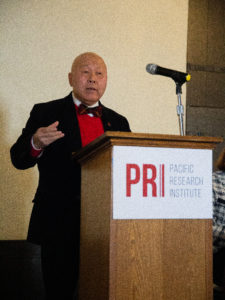The following is an address delivered by Lance Izumi at the recent 2023 Pacific Research Institute Sacramento Conference at the Sutter Club.
California’s urban areas are in decline, but empirical evidence shows that one possible solution holds out hope for the state’s distressed cities – expanding parental choice in education.
It has been long known that the academic performance of students in California has been terrible. But California’s failed education policies during the COVID pandemic, such as school closures that went on and on, resulted in huge declines in student achievement from already low pre-pandemic levels.

For example, the proportion of California eighth graders performing at the proficient level on the national math exam fell from a pre-pandemic 29 percent in 2019 to just 23 percent in 2022. The performance drop-off in struggling urban areas was especially pronounced.
Take Stockton in Northern California, for example. In 2019, 33 percent of Stockton students met or exceeded standards on the California’s math test. By 2022, only 15 percent of Stockton students met or exceeded the state math standards. In other words, the proportion of Stockton students meeting the state math standards was cut by more than half.
The poor performance of California’s public schools is so bad that students are just not showing up to schools. The Los Angeles Times has reported that California parents are pulling their children out of school “because they’ve lost confidence in the education system’s ability to meet their needs.”
For instance, the Times profiled an eight-year-old Los Angeles girl who has dyslexia, but who was forced to sit in front of a computer screen all day because her school was closed during the pandemic. The young girl would cry all the time. Not surprisingly, the girl’s mom pulled her out of her public school. That mom was not alone.
Last year, California public school enrollment dropped by more than a quarter of a million students. For the first time in 20 years, public school enrollment in the state is below 6 million. What can be done to improve this situation, especially in our urban areas? Well, expanded parental choice offers lots of benefits.
First, parental choice in its various forms, such as giving students greater access to charter schools and private schools, offers great academic advantages. A comprehensive study by the University of Arkansas found that students using vouchers to attend private schools made large gains in both math and reading.
Similarly, historically students at California’s charter schools have performed better than students at regular public schools, and this has especially been the case in urban areas such as Los Angeles and Oakland. It is important to note, however, that greater school choice offers urban areas more than just students who will do better academically.
For example, a study by the University of Texas at San Antonio looked at a voucher program in the historic city of Edgewood, which is near Dallas. Not surprisingly, the study found a significant rise in student performance “with large increases in graduation rates, ‘exemplary’ and ‘recognized’ schools, and faster growth rates in test scores.”
But that wasn’t all the study found. In addition, the researchers found that the “’community effects’ are the most noteworthy results of the (Edgewood voucher program).” According to the study’s findings, “the voucher program had significant positive impacts on single- and multi-family housing numbers and market value, (and) commercial development.”
Prior to the voucher program, the city had experienced years of declining property values. But over the 10-year span of the voucher program, “the total value of the property on the tax rolls within the boundaries of the (Edgewood Independent School District) rose by 86 percent.”
Because people were drawn to Edgewood due to the voucher program, government school leaders’ dire predictions of district revenue losses never materialized. Indeed, the voucher program caused a $6,500 rise in the value of the average school district single family dwelling, which netted the district an extra nearly $11 million in additional local property tax revenue.
The district’s total revenue per pupil rose 70 percent during the 10-year term of the Edgewood voucher program. “Clearly,” said the study, “as already documented by property value, mobile home, and business formation data, families were moving to Edgewood.”
This school-choice effect on urban population growth is important because major cities in California have been losing population. Los Angeles, San Diego, San Jose, and San Francisco have lost a combined nearly 90,000 people in recent years.
If parents in these California cities had a school-choice tool, like the Edgewood voucher, to ensure better education options for their children, the impact could help reverse these population trends.
Remember, the University of Texas study concluded that the community effects are the most noteworthy results of the Edgewood voucher program. According to the study, “A large segment of the population wants private school choice – even within the severe limitations of the current menu of school choices – badly enough to quickly relocate.”
The study conclude that, “increased business activity follows,” so a locality or state “interested in stimulating economic development, while also kicking their school system – public and private components combined – forward need look no further than a universal voucher program that offers a voucher amount large enough to nearly cover the tuition costs of most private schools, while avoiding price control by allowing families to supplement voucher funds with personal funds.”
There is an example of a universal school-choice program right on California’s doorstep in Arizona. Last year, Arizona enacted a universal education savings account program that allows parents to withdraw their children from public schools and receive a portion of their public funding deposited into an account, which they can then access to pay for private school tuition, online education or private tutoring. The amount of funding is set at 90 percent of the state’s per-student funding.
Arizona’s education savings account program is now the most expansive one in the nation and is a model to follow in all other states, including California. If California does not offer parents and students a broad school-choice program, then we will see increased homeschooling, especially in urban areas.
In my book, The Homeschool Boom, I profiled Alicia Carter, the head of the homeschool academy at Natomas Charter School in Sacramento. Alicia told me that “people are starting to consider homeschooling as a viable option, not a fringe option” and therefore “homeschooling has become much more diverse religiously, ethnically, and socioeconomically.”
“Now we’re getting a wider variety of people who are just doing things differently or want to do it their own way,” she added. For the first time in her homeschool academy’s history, they had to hold a lottery for admission. That’s no surprise, because the homeschool population has skyrocketed in California.
One way or the other, parents are not going to stand for the poor performance, poor campus safety and ideological indoctrination within the public schools. Whether California lawmakers give it to them or not, they will find better choices for their children. Therefore, for the sake of California’s cities, let us hope that policymakers open up those choices for our state’s parents.
Lance Izumi is senior director of the Center for Education at the Pacific Research Institute. He is the co-author of the new Pacific Research Institute book The Great Parent Revolt: How Parents and Grassroots Are Fighting Critical Race Theory in America’s Schools

